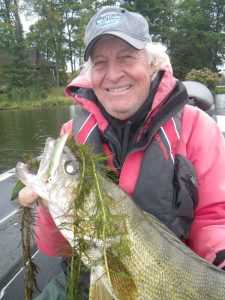
Category: Uncategorized
“The Splash” Freshwater Fishing Hall of Fame Press Release!
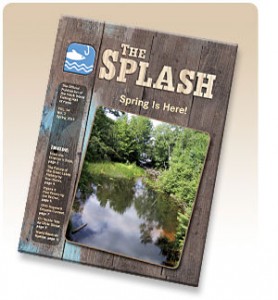 Greg Bohn hails from Wisconsin and his achievements are many. Bohn has spent his lifetime learning, developing, teaching and educating walleye anglers across the country. The knowledge, dedication and professionalism are undeniable. His 40-year contribution to the national walleye industry with promotion, education, tackle design, innovation and presentation techniques are truly pioneering. He is a world line-class walleye record holder in the catch & release division. Bohn has been a pioneer in the walleye tackle technology and presentation techniques for over 35-years. He designed, marketed and patented the first ever snag-proof walleye tackle products, while guiding on the snag infested waters of High Falls Reservoir and Turtle Flambeau Flowage. Many of Greg’s original walleye tackle inventions and patents remain a large part of todays walleye tackle industry, some 30-years later. Bohn has authored several books and has written over 150-feature magazine articles and contributed to hundreds more. This is just the tip of the iceberg when describing Greg Bohn’s legendary guide career in the fishing industry.
Greg Bohn hails from Wisconsin and his achievements are many. Bohn has spent his lifetime learning, developing, teaching and educating walleye anglers across the country. The knowledge, dedication and professionalism are undeniable. His 40-year contribution to the national walleye industry with promotion, education, tackle design, innovation and presentation techniques are truly pioneering. He is a world line-class walleye record holder in the catch & release division. Bohn has been a pioneer in the walleye tackle technology and presentation techniques for over 35-years. He designed, marketed and patented the first ever snag-proof walleye tackle products, while guiding on the snag infested waters of High Falls Reservoir and Turtle Flambeau Flowage. Many of Greg’s original walleye tackle inventions and patents remain a large part of todays walleye tackle industry, some 30-years later. Bohn has authored several books and has written over 150-feature magazine articles and contributed to hundreds more. This is just the tip of the iceberg when describing Greg Bohn’s legendary guide career in the fishing industry.
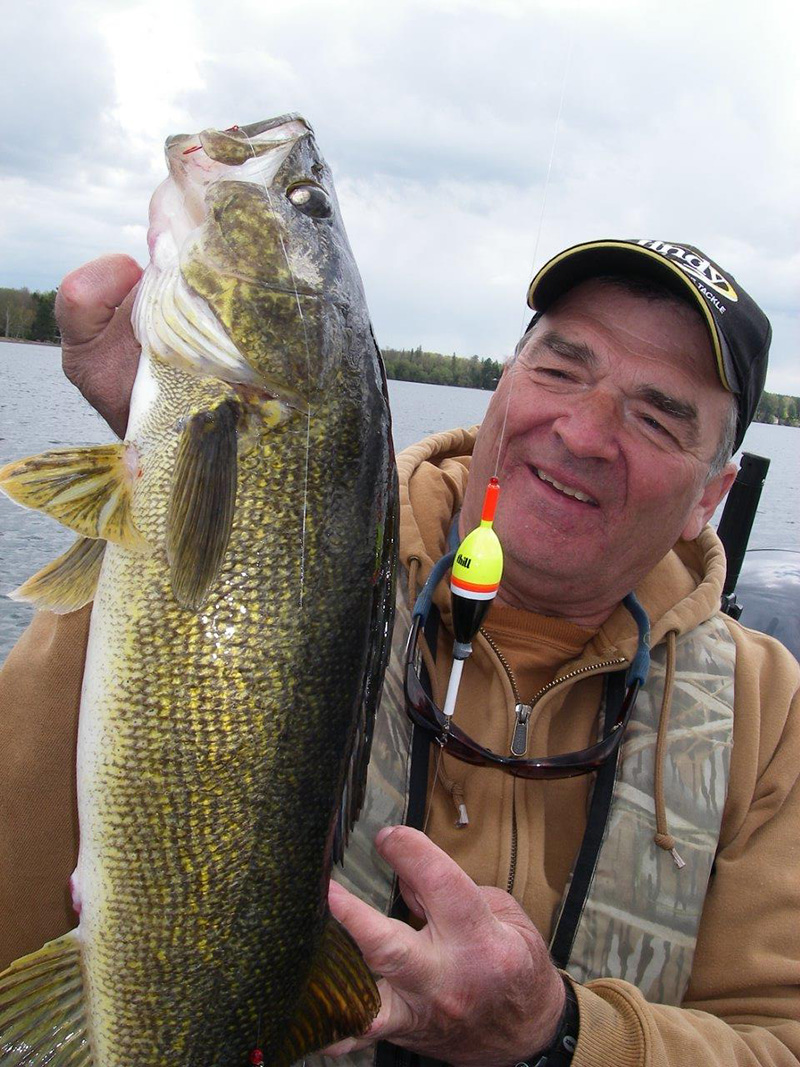
2016 Freshwater Fishing Hall of Fame Inductee
“Master The Art of Night Slip Bobbering” Book
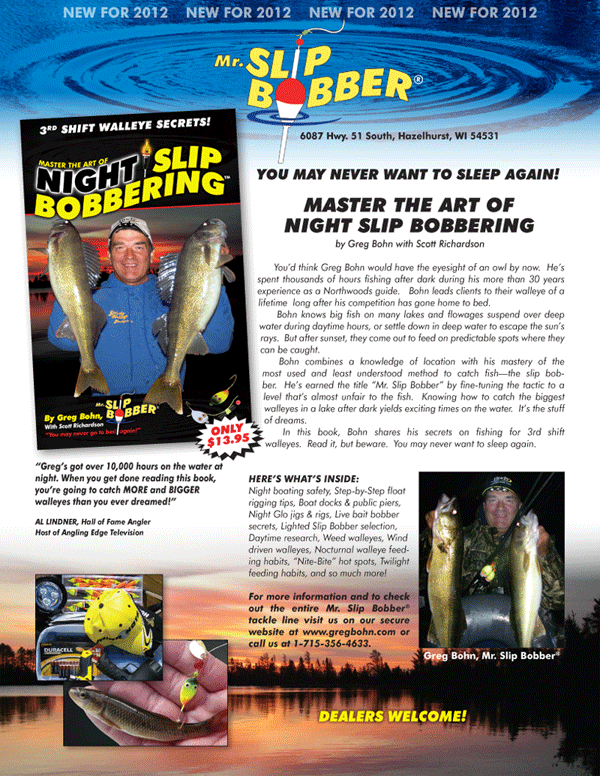
Northwoods’ Guide Masters The Art of Night Slip Bobbering by Ted Takasaki
By Scott Richardson and Ted Takasaki
Northwoods guide Greg Bohn has fished for walleyes at night since he was 7 years old.
His uncle, who owned the old Woods Motel and Resort in Arbor Vitae, Wis., would drive him to a dock or a public pier so he could fish well after dark. Sometimes he’d ride his bike if he couldn’t catch a ride. After a few hours under the moonlight, he’d usually head back home with a nice stringer of walleyes and panfish.
Bohn kept right on fishing after dark when he became a professional guide about 35 years ago. He realized the vacationers who wanted to fish in one of the hundreds of lakes around Minocqua were often too busy during the day with family to wet a line. Working men and women had jobs when the sun was up. Fishing at night offered hours of fun without taking time from other obligations.
But there was another reason Bohn loved fishing what he calls the “3rd Shift.” He and his clients are having breakfast after a night of setting hooks on fish after fish while other guides are getting ready to face a hard day on the water with tough conditions. While other people battled the dead-calm blazing-hot dog days of summer, he and his clients were home asleep after catching walleyes in the cool of darkness.
They usually catch lots of them. Some are the fish of their dreams.
“I’m having breakfast when the other guides are going out. We’ve already caught 40 fish and they’re looking at a flat calm day,” Bohn said. I didn’t have the heart to tell them, the walleyes stopped biting over an hour ago!
After logging 10,000 hours of night fishing by 2011, Bohn decided to share what he’s learned in his just-released “Master The Art of Night Slip Bobbering: 3rd Shift Walleye Secrets!” It’s his second book in the Mastering The Art of Slip Bobbering series written with Scott Richardson.
“Our average night is about 30 fish,” said Bohn. “There’s no way you’re going to do that during the day unless there’s perfect conditions. Most of the walleyes are 14- to 18 inches. But fish up to 15 pounds have been caught during the peak feeding times after dark, and it’s not uncommon to have a 7- to an 11-pounder on any given night. I am actually surprised if we don’t catch a big fish, what you would consider a trophy from 24- to 28 inches.”
Lighted Slip Bobber Warning: night fishing can be addictive. The image of thousands of walleyes becoming active at sunset after a day in deep water or holding tight in the weeds to escape the sun can fire up the imagination.
“There’s something mesmerizing about watching a lighted slip bobber, slip under the water and then come back toward the boat as you fight a fish,” he said. “It’s become such an obsession, I don’t sleep at night. Even when I’m not booked for a night trip, I want to be there because I know what’s going on.
“What better way to catch walleyes than with live bait under a lighted slip bobber? I’ve tried to out-fish lighted floats with jigs or with lures. Can’t do it.”
Bohn seems to have a sixth sense to predict when the best bites will be on any given night. But there is a science to his methods. Using charts that plot the motion of the sun and the moon and weather forecasts, he times the sunset and sunrise, the moonrise and set and the arrival of clouds or stormy weather to be in the right place at the right time. He’s found that weeds give up the most fish, “a sure thing,” he said, but they tend to be smaller than the walleyes that haunt hard-bottom structures. You may get far fewer walleyes fishing mid-lake humps and shoreline bars, but the ones you get are trophies worth losing a little sleep over.
His approach isn’t solely for insomniacs willing to stay up all night. Bohn nets walleyes while the red taillights of the trucks and boat trailers are still visible at the ramp or when trucks are showing back up next morning. People are loading their boats and arranging tackle boxes while he’s netting the best fish of the day. He knows the catch rate of the average evening angler would soar if they would just learn to use lighted slip bobbers and stay on the water a couple of hours longer in the evening or arrive a couple of hours earlier in the morning.
New technology has opened night-fishing to far more people than in the past, he said. In the old days, he had to wrap the head of slip bobbers in tinfoil or prism tape so they’d shine when he pointed his flashlight their way. He was in heaven when Lindy Legendary Fishing Tackle started to paint the tops of their bobbers with paint that would glow and reflect light. Fuji came out with lighted bobbers. Lindy entered the market with Nite Brite floats. More recently, they offer models like the Splash Brite slip bobber that turns on when they hit the water and turn off when they are taken out to extend the battery life.
Those advances add to a number of tweaks Bohn made to the common slip bobber rig that he and Scott outlined in the first book and discuss again in the new book. Bohn uses the thread style bobber stops to avoid damaging line. He uses rubber core sliding sinkers instead of split shot pinched on the line for the same reason. He’s fine-tuned the use of glass beads and he’s figured out the best terminal tackle to make a rig that is both attractive and strong so it won’t cause him to lose trophy fish. He knows what hooks to use with what blades and he’s developed his own line of “3rd Shift Glo-Bugzzz Jigs to draw fish close and present minnow, leech or ‘crawler in a way that entice strikes.
He’s refined the presentation to the point of offering different set-ups to address different conditions from cloudy to moon, no moon, and everything in between. One of the Bohn’s most insightful chapters discusses how to “charge” baits with natural or artificial light to match the natural illumination the moon provides or the lack of it.
“The only way you can accumulate that kind of information is to spend 10,000 hours on a lake or buy the book,” Bohn laughed.
“Master The Art of Night Slip Bobbering: 3rd Shift Walleye Secrets!” is priced at $13.95 plus shipping. Buy one online at the Strictly Walleye secure online web site www.gregbohn.com or call 715-356-4633.
Pothole Potential! Iceing Monster Bluegill’s by Greg Bohn with Scott Richardson
Pothole Potential – Monster Bluegills!
Traveling light with bucket in hand and being willing to hike a few hundred yards down a trail can pay huge dividends.
By Greg Bohn and Scott Richardson
Ice fishing for bluegills can be slow on major lakes and reservoirs when blue-bird skies signal that high pressure has arrived. Picture a huge hand on top of the hard surface. Just like when it’s warm, the hand presses downward as high pressure arrives. Fish hunker down and don’t move around so much. Small baits have to be put right on their noses or forget about it!
Ice fishing also can slow down as winter wears on. Weeds die and sap the oxygen out of the water. Fish become lethargic and slow to bite.
But, stay at home? No way. When fishing gets tough on the big water, the tough get going. They make their own paths to small potholes that dot the countryside.
Many potholes are public waters. They may be only a few acres in size. But, most have bluegills in them, and some can be dandies. Some potholes host stunted fish that will never reach more than 5 inches or so. But, the picture becomes brighter when predators like otters or bass control bluegill numbers and reduce competition for limited food. Fish can grow big. We’re talking 9-inch ‘gills. Some will reach 10 inches and more. Yet, many anglers overlook the pothole potential.
“The bite is always there, but finding the right pothole with the right-sized bluegills is the trick,” said Greg Bohn, a top Northwood’s guide from Minocqua, Wis., who’s made a study of potholes “Catching a bass should turn on a switch, it should excite you. The bluegills should be big.” Largemouth Bass keep the bluegill population in check!
We’re also talking about a winter experience that creates memories. Boots crunch across the snow leaving the first evidence of humans amid hundreds of animal prints. Surprising a white-tail or two on your trek is common.
“It’s always an adventure. The scenery is often unbelievable,” Bohn said. “I’ve been burned on potholes before But, I’ve also had bluegills that have snapped my 3lb test line.” Were talking Bull Gill’s!
Finding the right potholes can be as simple as keeping your eyes peeled as you drive down the highway. Or, check out a county map or a Gazetter for the area. A tiny speck of blue in an out-of-the-way place can translate to big bluegills.
Other guys want it easy. They want to drive their truck or ATV or snowmobile out on the ice with their shanty in tow. They want to fire up a heater, lower a bait and catch fish. But, traveling light with bucket in hand and being willing to hike a few hundred yards off road, or down a trail can pay huge dividends. Some potholes are located in deep down in steep ravines. Getting there can work up a sweat. But it also keeps angler traffic to a minimum.
Potholes are exactly what their name implies, holes. Don’t expect any major structure to analyze. They simply start shallow at the edge all the way around and end in a deep hole in the middle. Bluegills will be deep in the middle of the day and move toward the edge where they do most of their feeding in the afternoon and evening.
Bohn said the timing of their movements means anglers should be on the ice drilling holes by noon. The water color on potholes is brown, but fish will spook in shallow water nonetheless, so holes should be drilled all at once. A few in the middle will keep you busy enough mid-day. Water can be as deep as 25 feet or more at the maximum. But, having holes already drilled will let you follow the fish from deep, to shallow water where the real action occurs before dark. Don’t leave too early. The action may come fast and furious in a 15- to 30-minute burst just before you need a lantern to see. Bohn says the biggest bluegills in the pond will wait until its almost dark!
Don’t bother drilling holes in less than 10 feet of water. The most productive range is usually 11- to 14 feet. Once you reach that point, spread holes along the edge rather than drilling more closely to shore.
During the day, they’ll be suspended slightly off the bottom over the deepest water in the pothole. By 3 p.m., poof, they’re gone. They are making their way to dinner. A Good sonar like my Humminbird Ice 55 is a necessity to keep pace. The unit has a digital LED read-out of the depth right at the center of the screen. When you put a cursor on the fish marks, the read-out tells you exactly how deep the fish are. It has a fully-adjustable zoom function that lets you zero in on a specific range. You can set a color palette that turns one color when the bluegill is at the edge of the sonar cone and then changes colors as it moves to the center of the cone to attack your jig. The Ice 55 also allows you to choose between a 19-degree angle, which is a wide view best for bluegills in shallower water, and a 9-degree angle that is great for focusing on perch or walleyes in deep water.
Use standard medium rods and don’t get hung up on paying a lot for them. I personally use the Dave Genz Stick, which makes a great durable bluegill rod. The trip across country can claim rod tips as you maneuver through the tree branches. Forget the spring bobber. These fish are anxious and bite hard. Stick with 2-pound Berkley Cold Water line and make certain you keep the holes clear of ice or the circling action of a big fighting ‘gill will cut you off.
Given the brown color of the water, bright jigs are best. Try brighter colors li
ke the K&E jig brands. Orange glitter and white glow, reds and chartreuse. Lindy Frostee jigs in the size #8 come in chartreuse/orange glow. Bohn commented that’s a big fish lure. Lindy Fatboys in the Techni-glo pink and Techni-glo chartreuse down to size 10 and 12 are killers. Use a small ice jig snap so you can change up easily without having to retie in the wind with cold wet hands. Never try to fix a tangled line when the bite is hot. Save that mess for home. Just pick up another rod and keep fishing.
Wax worms are the best live bait by far. Thread it on the jig and pinch it lightly to get some body scent into the water. That’s very important. Leave one on after catching a fish or two. They actually seem to do best when they are torn up.
Plastic baits work, too. In fact, on cold days, they seem to do better. Lindy’s Pintail, split tail and mini-spade come in Techni-glo colors like glow red, glow chartreuse and moonlight that add to the attraction. When using plastics, turn to “rockers.” They’re longer and thinner than a teardrop jig and have a slight bend to them. Thread the plastic on so the tail end points up at 2- to 3 o’clock. The bait will look much like an “L” when it’s done right.
It’s always best to start your jigging technique on the bottom. Silt creates a small space between the actual bottom and the bottom line on the flasher. That’s where the big gill’s hangout. I’m amazed at the Ice 55’s ability to pick out bluegills holding tightly into the silt. The LCD Flasher technology is priceless to panfish anglers. Bluegills hold so tight to the bottom they might not appear until you lower the jig to the bottom and then slowly raise it up a foot, two feet and three feet at the most. Twitch the jig while going upward and stop, and they’ll nail it.
“You can spark a feeding frenzy where two or three fish will follow the jig up to fight over the bait. That’s when it gets fun,” Bohn said.
Unlike larger lakes and flowages where the “bluegill bite” might extend beyond darkness, the coming of night to pothole fish is like turning off a switch. It’s over! Time to head home for a winter evening fish fry and remember how much fun it was to tap the pothole potential.
Bohn’s Quick Thinking Slip Bobber Rigging!
Quick Thinking Slip Bobber Rigging!
by Greg Bohn with Scott Richardson
Fumbling around trying to keep bait in the water costs time and missed fish when the walleye bite is on.
Action can happen fast and furious and ends just as quickly. Being prepared and making adjustments to your slipbobber rigs in a hurry can mean the difference between two fish or twenty. Advances in tackle design, packaging and storage help you stay in the thick of things.
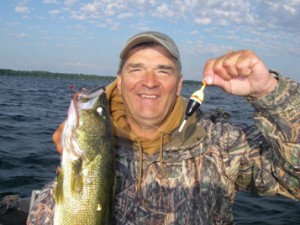 Start right. A split shot, a slipbobber, a bobber stop and a hook aren’t enough. Today’s slipbobbers are as versatile as any other method to catch ‘eyes – maybe more so. They can be used with minnows, ‘crawlers and leeches. They can sport different colored hooks or jigs like the Bohn-designed Bobber Bug.
Start right. A split shot, a slipbobber, a bobber stop and a hook aren’t enough. Today’s slipbobbers are as versatile as any other method to catch ‘eyes – maybe more so. They can be used with minnows, ‘crawlers and leeches. They can sport different colored hooks or jigs like the Bohn-designed Bobber Bug.
A Bohn brainstorm led to the addition of a small blade to the Lindy Pro Series snells. The flash caused when a squirming leech or minnow tries to escape is sometimes all it takes for the walleye to pull the trigger. The rigs produce 50 percent more strikes than the common slipbobber, split shot and hook.
In our book, Mastering the Art of Slipbobbers: The Deadliest Method for Walleyes, we described the modern slipbobber rig. A bobber stop made of thread is followed by a red glass bead that adds enough color to be seen from a distance and slides smoothly to prevent hang-ups. Next, the slipbobber must be designed to slide easily on the line. That’s followed by a Lindy No-Snagg barrel swivel which features one eye larger than the other. The bigger one goes toward the slipbobber to prevent the swivel from becoming stuck inside.
A Water Gremlin rubbercore sinker – not a split shot – is attached halfway down the 2-foot snell. A split shot damages the line. The rubbercore sinker balances the bobber without weakening the line at all and allows weight changes quickly.
The business end is a Tru-Turn hook in bleeding red or gold or a Bobber Bug in perch or firetiger, the most consistent walleye-catching colors. Bobber Bugs range from 1/32 , 1/16 and 1/8 ounces. The Pro Series offers five different floats from small to XX-L. Different sizes may impart different action to the bait below or slow or speed the drift. They also come weighted, which allows casts into the wind, or without weight. Rubbercore sinkers in -, 1/8th- and 1/16th are all that’s needed to match the bobbers. Hook sizes vary from #2 for large chubs and leeches to #4 and #6 for smaller minnows, leeches and ‘crawlers. Never leave the dock with only one kind of live bait. Even if you know walleyes are hitting minnows, take a couple of different sizes along. If you think they may want leeches, take ‘crawlers, too. Set the rig so the bait is a foot off the bottom.
Use Tru-Turn hook snells when the water surface is calm. A little bit of flash from the petite blade spinner and a little bit of color is enough. Jigs are best in rough water. Try the Bobber Bugs with big live bait, a whole nightcrawler and big leech.
Hooks tend to be used more with minnows and leeches. Bobber Bugs get the call with ‘crawlers and leeches.
But, the critical factor is to use all those options of colors, sizes and bait choices to give walleyes several options to pick from at the start of every day. It’s rare to have a day when every rig is working. Every day they make a choice based on color, jig versus hook, the blade and the bait. One will out-produce the others. Something in that rig is working. Whatever they’re hitting repeatedly and for whatever reason, you’ve unlocked that day’s rigging secret. Immediately respond. Duplicate, duplicate duplicate that rig. Your walleye catch will soar. The walleyes are telling you what they want. If you react immediately, the catch goes from three to thirty.
Pre-tied rigs can be changed simply by cutting the line above the snell to remove one and tie a single knot to add the other. Prepares at home by choosing several snells and store them on Lindy Rigger Extremes. Extra sinkers, Bobber Bugs, hooks, glass beads and bobber stops fit inside the Riggers, which are then placed in clear plastic storage containers for easy viewing. When one rig starts producing, you can find more in a hurry.
Avoid tangles. Two rods per angler are enough, even in places like Wisconsin that allow more.
When you find a hot combination, don’t fall in love with it. Fish can change preference daily, even hourly. Change up when action stops. After pounding them, they’re going to want a change.
Slip Bobbering Early Season Walleyes by Greg Bohn with Scott Richardson
Slip Bobbering Early Season Walleyes! by Greg Bohn with Scott Richardson
Two traits of spring, a strong breeze and cold water, make the season the perfect time to target walleyes using slip bobbers.
Nothing ignites the action of bait below a slip bobber more than wind-driven waves on the surface, and a stiff southerly breeze common early in the year helps concentrate fish on structure.
Add to that the fact walleyes in cold water will bite, but not chase, and it’s clear why slip bobbers that suspend a bait in front of a hungry walleye will outpace other faster presentations.
A third factor also should make up your mind to reach for slip bobbers in April and May. Walleyes are often shallow early in the season. Though slip bobbers are great tools for deep water, they shine when fish are in water less than 10 feet deep.
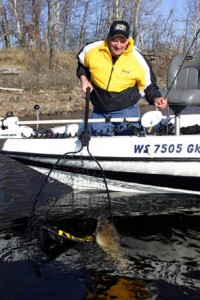 Finding Early Walleyes
Finding Early Walleyes
Temperature is key to locating active walleyes early in the year. Lakes of 500 acres or so, especially those with dark bottoms, will warm first. Walleyes there could be spawned out while walleyes in mid-sized lakes or larger lakes are in pre-spawn mode or spawning. Walleyes lay eggs from 42 degrees to about 48 degrees. Once water reaches 50 degrees, slip bobbers are killer. Choose lakes where walleyes have just finished spawning, which should offer the chance to catch both male and larger female fish.
Temperature continues to play a critical role once you’ve targeted a specific lake. Even if water is only slightly warmer than the surrounding area, walleyes will find it. A difference of just a couple of degrees can mean the difference between no fish and fish.
Remember, too, temperature on a body of water can swing significantly in spring during the course of a day. The coat you wore at sunrise is off by 10 a.m. Preferred location can change just as dramatically. Some anglers might think the fish quit biting. But, they simply moved.
Structures that offer hard bottoms, including shoreline points, islands and mid-lake rock structures, are likely to hold the most walleyes.
The best points offer rocks, newly emerging weeds or wood. One stump may hold many fish, and it will day after day.
Islands with gravel bases deserve extra attention. Mid-lake rocky structures are great, too, if they’re shallow enough to allow the sun to warm them.
Sand bars with fingers and bays with sandy bottoms are also tremendous fish attractors. They may look too clean, too featureless, to hold walleyes, but they do. With flat bottoms and depths of 10 feet or less, they’re perfect to attack with slip bobber rigs.
The best structures will be the ones where the wind is pounding the hardest because warm surface water will be blown there.
Don’t be afraid to change lakes in the course of a day, too. Fish might be shallow early in a clear water lake, then move off to deeper water where they are harder to catch as the sun rises. If that happens, pick a darker, stained-water lake for mid-day action.
Boat traffic is another consideration. Walleyes are skittish at this time of year, so fishing busy places can reduce your odds in a hurry. Try to stay off the beaten path.
A Strategy That Works
Slip bobbers have a drawback. They can be a very slow way to find fish. Try using a jig to locate “Judas” fish, the active ones that bite faster presentations. They give away the location of the school. Once you know where the fish are, slow down with slip bobbers, a presentation more in tune with the overall mood of the walleyes in colder water.
The basic slip bobber rig includes a thread bobber stop, a glass bead, a slip bobber, a Lindy NO-SNAGG barrel swivel, a leader of line lighter than the main line and a hook or jig.
Best slip bobbers for springtime conditions are weighted to let you cast into the wind. That lets the breeze work for you by blowing the slip bobber back to the boat and beyond to cover a larger area searching for fish.
There are lots of floats on the market, but stick with ones that are painted and visible. One good choice is the new Thill Pro Series. The large is PSW 115, the medium is PSW 110. The weight is removable. Or, if you prefer non-weighted models, the PS 115 is the large and the LS 110 is the medium.
The Gold Medal Supreme Super Shy Bite (IM 201) is another great choice. They have easy-on, easy-off capability to adjust the size of the float to meet changing conditions in wind, depth or the distance you want to reach.
The Float-Hi 783W in pink or orange is a highly visible foam float.
Choose a float one size larger than you think you’ll need. The primary bait you’ll be using is a redtail chub, a sucker or a fathead minnow. A three can pull small floats down, giving false hope of a strike.
Always take at least two bait choices along. One of the trio may be the primary forage of a lake or walleyes may just prefer one over the other two on a given day. It can be a long day if you don’t have the right one along.
Gold hooks seem to work best early in the year. Use a number 4 or number 6 Mustad Aberdeen for fatheads. Switch to a bleeding red Tru-Turn in a number 4 or number 2 for larger chubs.
Add a red glass bead and a small 0 or 00 Colorado or Indiana blade on a clevis above the hook. When you are drifting or the minnow swims, the blade gives off a flash that walleyes like. A silver blade is best in clear water, a gold blade is best in stained or darker water.
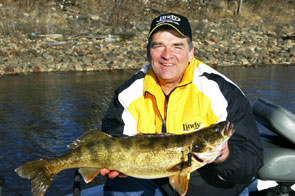 The Business End of Rigging
The Business End of Rigging
Hook the bait between the dorsal fin and the tail. It must appear lively, so change bait often.
Set the bobber stop so the bait is about one foot off the bottom, the most active zone.
As you drift and cast a jig, set bobbers near the boat, including at least one directly in the cone of the electronics. Watch for signs of fish moving toward the bait, but balking before they take it. They might not like the size of the chub or it may be a sign to change to a fathead.
If you catch one, toss a black buoy to avoid attention or better yet, mark a waypoint on the GPS. Drift beyond the spot before carefully and quietly dropping anchors to thoroughly fish the area. Where there was one walleye, there’ll be more unless you make too much noise pounding an anchor on the bottom. If action slows, start the search again.
Ice Perch’n Wisconsin Style by Greg Bohn with Scott Richardson
Ice Perch’n Wisconsin Style by Greg Bohn with Scott Richardson
Mention Vilas and Oneida County, Wis., to an ice fisherman, and he’s likely to think, “walleye,” or “crappie.” But, when the weather turns bitter cold, Oneida County fishing guide Greg Bohn thinks of another species that’s often overlooked – nice yellow perch.
“People typically come here for tip-up or tip-down walleyes,” said Bohn. Those that don’t, fish the hard water for bluegill and crappie. “But, we have very, very nice perch that have gone unnoticed for years.”
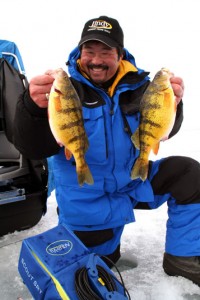 Wisconsin perch are being discovered as restrictions on perch are tightened in other states better known as winter perch destinations, such as Minnesota or the Dakotas. Perch in those places I agree may be bigger on average. But Wisconsin perch average 8.5 to 11 inches, and you can harvest 25 of them each day. That ain’t all bad! Perch here are plentiful and according to Bohn, could use some angler pressure. Add crappies many up to 13 inches and a few nice big bluegills to the 25-a-day panfish limit and you have an ice angler’s dream.
Wisconsin perch are being discovered as restrictions on perch are tightened in other states better known as winter perch destinations, such as Minnesota or the Dakotas. Perch in those places I agree may be bigger on average. But Wisconsin perch average 8.5 to 11 inches, and you can harvest 25 of them each day. That ain’t all bad! Perch here are plentiful and according to Bohn, could use some angler pressure. Add crappies many up to 13 inches and a few nice big bluegills to the 25-a-day panfish limit and you have an ice angler’s dream.
No matter where you fish for perch, Bohn has an approach that works. That’s very evident by the many anglers watching his whereabouts. Here’s how:
Perch location
Perhaps the hardest thing about perch fishing through the ice is finding them.
Narrow the scope of the search by stopping at bait shops to ask for the latest information on where perch are biting. “If they mention a particular lake, you’re ahead of the game,” Bohn said. Be specific when asking lake questions and perch locations, as hundreds of lake choices are available. In Vilas County and neighboring Oneida County, expect to hear names like Big Arbor Vitae, Carrol, Big St. Germain, Minocqua and North & South Twin Lakes. “Those would be good choices to get started,” he said.
Once you arrive, watch for other perch anglers. This can be a good indicator on where perch schools are roaming on any given day. Stay on the outside of any perch pack and be advised; “Perch move a lot,” Bohn said. “They will eat everything in sight and move on. You might catch a bunch in one area one day and go back the next and not catch a one.”
The lesson in that bit of wisdom is this – to find perch, you must stay on the move, too. Use portable ice shanties like the Fish Trap designed by Dave Genz.
Bohn focuses on two basic patterns. One concentrates on shallow perch working the remaining green weeds. The other centers on deep water, usually mud flats and deeper holes.
Early winter and weeds perch may be their eating small leeches and insect larvae. In deep water, they are probably focusing on microscopic zooplankton or mayfly larvae known as “wigglers.”
If fish aren’t in one of those places, they will probably be in the other.
Start by checking for shallow weed fish first. Check weed patches on the edges of bars or dropoffs on the edges of flats. Those locations can produce all winter and become overlooked in exchange for deeper water areas. Perch will migrate along the sides or over the tops of the weed patches. Some larger crappie size minnows help to eliminate small perch!
Drill lots of holes and fish each one. It’s often impossible to see these fish on the flasher because they can stay so tight to the bottom or in the vegetation. You can’t tell if fish are there unless you drop your bait down to see. An underwater camera like an Aqua-Vu can do the trick, too. “It’s a mistake not to put a minnow or a waxie or a wiggler down the hole. I can’t tell you how many times I’ve limited my fishing, by not searching,” he said. Searching with the Vexilar Flasher might work for bluegill, but don’t be fooled into thinking perch are not available.
If no fish are biting after a few minutes, head for deeper water. Depending on the lake, deeper water can mean 20, 40 even 60 feet. Fish go deeper and water temperature drops until they start to move shallower again in late February while preparing to spawn on sandy bottoms. Perch are the first species to reproduce each year.
Look for deep mud flats off the tips of points. Bohn uses the newer model Vexilar FL-18 package with the zoom feature. He can concentrate on the area closest to the bottom where the fish are.
In low-light conditions at sunrise, a band of zooplankton often clutters the view of the bottom as they emerge from the mud. That’s a good sign. Perch won’t be far away. They love that stuff.
Bohn also likes the Aqua-Vu SV-100 and Aqua-Vu Scout SRT, which features Spectral Response lighting. Bohn seems to think that attracts zooplankton beneath his hole and jigging area. An accessory Ice Pod Stand will keep the camera lens out of the mud.
Found them? Now what?
Bohn uses two different set-ups depending on the presentation he wants to use. For jigging, Bohn likes the Dave Genz rod series in 28- and 30-inches. He uses 4-pound Stren Magnathin, which has the diameter of 3-pound test. Helps hold onto the occasional walleye bite.
One of his favorite baits is a Nil’s Master spoon, a narrow spoon that has a short chain for added flash and action. Bohn also uses size zero or size 1 Swedish Pimples. Another good choice is a size 1 System Rattl’r or a small #6 Genz Worm. Try the new Techni-Glo colors, especially in times of low-light. When do these Glo color patterns work-all day!
Try adding a split shot a few inches above the jig in order to get the bait down quickly to avoid wasted time. Add three of four “spikes,” wigglers or two waxies for action, smell and taste of natural bait. When fishing for perch, it is critical that the bait is alive.
For finesse fishing, Bohn turns to a shorter ice rod of 18 or 24 inches still-fished in a second hole. He adds a spring bobber to the tip, and then pastes a glow bead on it to make light strikes easier to see. Add a Thill Pro-Series Float PS105 or PSW105 (Weighted) designed by Greg rigged as a slip float for super light bites and for minnows. The new Pro Series Floats are getting huge acceptance from ice anglers across the Midwest.
With a crappie-sized minnow, use a split shot, hook or ice jig. Hook the minnow near the tail. This increases the action and perch like to take the minnows headfirst. If the minnow tires, simply pick up the rod and jiggle it; that often wakes the minnow up and provokes a quick strike.
Don’t be surprised if you take a bonus walleye or two.
Perch action is good all the way to ice-out in late March. There have been years when Bohn is still on the ice April Fool’s Day.
Next time you think about Vilas and Oneida County, Wis., don’t automatically think of walleyes. Think perch.
Bohn enjoys the day with his clients, having a cookout right on the ice. He provides everything you need and all you have to do is show up. Strictly Walleye Websitewww.gregbohn.com Phone him at (715) 356-4633.
Jig’n Up Winter ‘Eyes by Greg Bohn with Scott Richardson
Jigg’n Up Winter ‘Eyes by Greg Bohn with Scott Richardson
Ice jigging for winter walleyes is a fast growing technique spreading across many lakes in the Northwoods of Wisconsin, and for good reason – the method guarantees ice fisherman better walleye success. Greg Bohn
It’s an exciting way to catch walleyes through the ice and can be done as a single tactic or in addition to setting tip-ups. In Wisconsin, we are legally allowed to fish with three lines. I can drill and set two tip-ups and have a third option reserved for my walleye ice jigging rod.
You can trigger strikes during the daylight hours when nothing else works. But, my favorite time is after dark with glow-in-the-dark lures. Rattle lures also will out-fish all other tactics after dark. Even lures like a Cicada which offers strong vibration when jigged upward can increase the amount of walleye strikes on any given night.
The spinning rod and reel combo used for ice jigging is nothing like summer fishing equipment. Choose short 24- to 30-inch rods with a medium to heavy action size. Be sure to select ones with large eyelets as ice build-up is common. The ultralight reel should fit comfortably in your hand with gloves on. Good examples are models like the Tiny 20 ultralight reel, Shakespears 2500 ULX or Shimanos TX500. Spool up with #6 Stren Magnathin, #6 Berkley Cold Weather or #10 Berkley Fireline, which is my favorite. Always ask your favorite sport shop sales person for their recommendations as they know what working.
Remember to set your drag. It should be lose enough to slip when you set the hook. All fishing lines break easily under cold conditions. Also, keep the line guides free from ice buildup whenever possible. Sharp ice will cut a line when the hook is set.
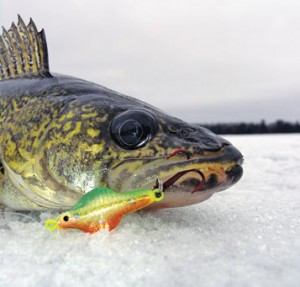 There are always several good “go to” lures and many that aren’t. The old standbys like the size #3 and #4 Swedish Pimples, #3, #4 and #5 Jigging Rapalas will catch their share of nice walleyes. But with the growing interest in this method several new exciting choices are now available. They include the #2 and #3 Nils Master Jigging Series, Lindy’s Rattl’n Spoon and Northland Tackle Buck Shot Rattler in the 1/8 and 1/4 oz. sizes. Perch patterns, silver shiner, firetiger, and glow color patterns are very popular choices.
There are always several good “go to” lures and many that aren’t. The old standbys like the size #3 and #4 Swedish Pimples, #3, #4 and #5 Jigging Rapalas will catch their share of nice walleyes. But with the growing interest in this method several new exciting choices are now available. They include the #2 and #3 Nils Master Jigging Series, Lindy’s Rattl’n Spoon and Northland Tackle Buck Shot Rattler in the 1/8 and 1/4 oz. sizes. Perch patterns, silver shiner, firetiger, and glow color patterns are very popular choices.
Use #0 and #1 Split Rings on all your lures and spoons to enhance the swimming action.
When strikes are few and far between, try tipping the spoons with the head of a fathead minnow or Milwaukee shiner. This can trigger immediate strikes. Even when I leave my tip-ups behind, I still bring along a couple dozen fatheads or shiners for tipping purposes.
Also, a couple waxies on the treble hooks of either the jigging lures or spoons can be dynamite.
Try ice jigging for walleyes in the same productive areas that tip-ups work. Weed beds, rock bars and deep mud flats are a few popular areas.
I start out jigging in the green weed beds in the 8- to 12-foot range. The early-ice green weeds will still attract baitfish and predator fish to that area. Winter walleye schools quickly come and go, as we all know, but if a walleye swims into my jigging area- I will most likely catch it.
Drill several holes prior to setting your tip-ups and jigging. By doing this you will be less likely to spook a walleye or school of walleyes that move into your area. Never drill or chop holes during the key fishing hours of dusk or after dark.
Move often from hole to hole because any hole can yield up to two quick fish. It’s rare to catch more than 2 walleyes at a time as they quickly spook. But coming back to that same active hole after a short break is a smart and productive move. I can’t tell you how many times I’ve looked down into the ice-hole only to see several nice walleyes. I often would rush to place a tip-up there with a tasty looking shinner without success. Had I known more about this ice jigging method back then, I would have had instant strikes.
Just remember LPS location and presentation equal success! Ever sit on your bucket right next to an ice fisherman that is catching one fish after another, and you can’t buy a bite? It’s happened to us all. Those ice anglers that seem to always be successful at “ice jigging for walleyes” really have perfected the lure presentation and technique.
I’ll give you an example that I think says it all. I spotted a #3 lb walleye directly under my hole on Minocqua Lake as I was jigging my #3 perch pattern Rapala. The fish would not strike that lure no matter how I jigged it. Finally, I set the rod down across my pail after several minutes and, you guessed it, BANG. Who knows what jigging method will work on any given day? But, one thing is for sure and that is it’s important to mix it up.
Drop your lure to the bottom. Never hold the line in your finger-unless of course you don’t need that finger anymore. Close the bail and firmly hold the rod in your hand. Start out by moderately snap jigging the spoons or lures upward. Always hold tension on those lures as they free-fall back down. Stop the lure about one foot off the bottom and hold it there very still! Holding a (2- to 3-second) pause is best before repeating your jigging.
Occasionally tapping or lightly touching these lures on the lake bottom is a good way to provoke negative walleyes into striking. But remember, most walleyes strike the bait offering when it’s level or slightly upward. Many active walleyes are turned off, by the ice angler holding the spoon too close to the bottom. Keep repeating the method for up to 5 minutes per hole. Don’t get lazy. It’s important to keep moving and searching the various holes for active fish.
The best presentations are obviously those that work but you must also find the active walleyes. It’s amazing how quickly you can “Fine Tune” this technique. Each individual lure has its own special shake, wobble, sound and darting action. Experimentation is the neat thing about this method. It is a challenge. I’m always learning more every time out on the ice.
Give Jigging For Winter Walleyes a try next time you hit the ice. It’s exciting, productive and should not be overlooked! Drill allot of holes, move often and you’ll be hooked too!
